Greensboro Montessori School hosted two teacher workdays this fall, each dedicated on professional development. Classrooms were closed giving our team uninterrupted time to focus on learning new skills and growing as educational professionals. So how did the team use their time?
During our September 20 workday, faculty paused to reflect on the work we do with students every day and our approach to guiding them in their meaningful work. Nancy VanWinkle, instructional coach, and Jessica White Winger, director of student support, led a workshop designed to build teachers’ tool sets for preparing the environment, particularly expanding the resources of the prepared teacher. The theme was building a “Community of Reflective Practitioners,” with a focus on leveraging the collective experience of the educators in the room.
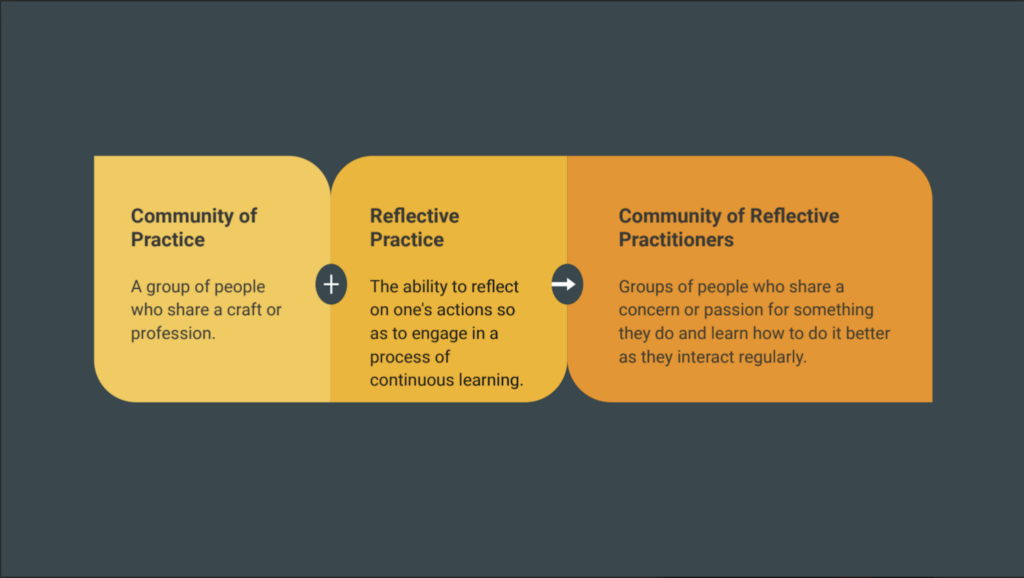
Teachers worked in mixed-division groups, with varying years of experience in the field. The morning opened with a grounding activity in which teachers were shown photographs of individuals who have affected positive change in the world. These individuals have raised awareness around difficult issues, often putting their lives and work at risk to do the “right” thing. Teachers were asked to work with their groups to list the qualities of one of those changemakers. Following a share-out, the group reflected on how we can encourage these qualities in all of our students. This impactful exercise grounded us in the knowledge that each child is under “self construction” and we have the big responsibility of allowing their true light to shine, while helping guide them in becoming their best self.
Following this exercise, Nancy and Jessica shared what resources and experiences they have to support teachers during the 2023-24 school year. As our instructional coach, a role dedicated to support faculty in their professional development, Nancy worked closely with Jessica to design a collaborative problem-solving approach for schoolwide implementation. The model offers teachers a practical tool for seeking input from one another and leveraging the cumulative knowledge of our faculty and staff.
This collaborative problem-solving model has teachers sharing a specific behavior they are experiencing with a child in their classroom. A group of educators, with one facilitator and one recorder, reflects on the overall question, “What’s going on with this child?” and what are the unmet needs, lagging skills, or obstacles that the student might be encountering? By looking at the heart of the issue, we honor the child and seek to better understand what their behavior is telling us. The facilitator then takes the group through a series of brainstorming questions, while the recorder writes strategies and suggestions. In the end, the teacher chooses a strategy to try out for a week and agrees to report back to the group. At that point, they may revisit the brainstorm and select another strategy to try.
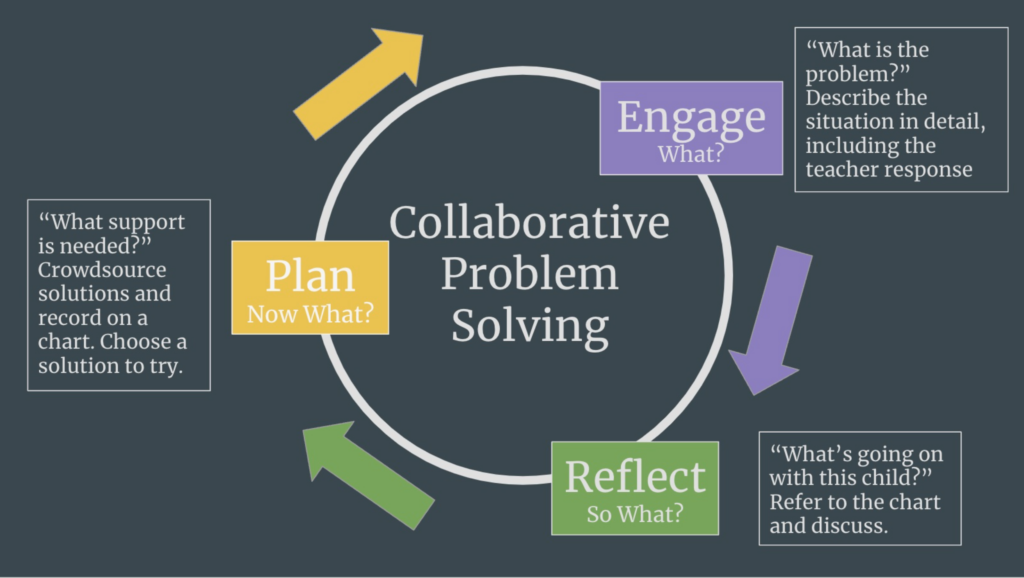
After modeling this process for everyone, teachers split into their mixed-division groups to practice the model. The value of this collaborative approach is vast, as it’s an opportunity for teachers to gain new perspectives and insight, helping create a shift in paradigm and introducing new ways of responding to student needs. It’s about connecting with colleagues and taking a child-centered approach, as much as it’s about reflecting on our own vulnerabilities and finding strength in the process. It is not about “fixing” a behavior, but opening ourselves to trying new approaches and embracing the spirit of the child.
During our October 6 teacher workday, our group of reflective practitioners reunited to share how our new system of collaborative problem solving is helping them in the classroom. Mixed-division groups reported out on strategy successes and areas of growth. More teachers had the opportunity to share a new challenge with their groups and seek strategies to try. Faculty feedback for this process has been overwhelmingly positive, and we are excited to be working closely together to authentically support students and to address their most critical needs.
Teachers spent the latter half of the workday looking at the scope and sequence of their Montessori curriculum, evaluating it with a fine-toothed comb to ensure fidelity and best-practice in every classroom. This “big work” is just one more way we are reflecting on our practice and ensuring that every student at GMS is engaged in meaningful work as they progress from Toddler through Junior High.
Through intentional planning, we make professional development at GMS relevant and meaningful. We consistently follow-up with faculty to ensure we are meeting their needs and supporting their professional growth. From workshops, trainings, and conferences to observations at other schools, professional development offers inspiration and connection for GMS teachers.
Over the course of the next few months, nearly half of the Toddlers in our School will be making a foray into the wonderful world of Greensboro Montessori School's Primary program. This transition brings with it a mixed bag of emotions for young children (not to mention their parents and teachers). Though the idea of becoming one of those big kids in the enchanting world on the other side of the playground fence can be very exciting, the thought of leaving behind beloved teachers and classmates and mastering the challenging materials in the Primary classroom can be very daunting for advancing toddlers. At times, well-meaning adults discuss this transition in ways that can actually heighten young children's apprehension. Here are a few things to consider as we prepare our little ones for a classroom transition:
Avoid "overtalking" about the impending changes. For adults, having ample opportunity to ask questions and share our feelings about an upcoming transition can be a comfort. We may worry that our children won't know what to expect from their new classroom unless we initiate frequent discussions and provide ample detail. For young children, though, too much information can be overwhelming and confusing. Because they learn experientially, young children may not grasp the reality of how things will feel in their new classroom until they have physically visited the space, met the teachers, and absorbed the sights, sounds, and sensations first-hand. It's perfectly fine to mention the change - conveying that you are excited about it and confident in their readiness for the new classroom - but, for the most part, it's best to follow your child's lead. The most helpful discussions will be the ones your toddler initiates!
Avoid tying new skills to Primary advancement. It can be tempting to entice children to practice new skills by pointing out how important they are for Primary students. However, suggestions that toddlers learn to use the potty, dress themselves, or tackle other developmental tasks "so they can go to Primary" can sometimes backfire. Even children who seem excited about the prospect of "moving up" can harbor anxieties about the transition ... and may not be so sure they really want to go. In fact, they may even delay the acquisition of self-care skills to avoid the prospect of being moved into a new and unfamiliar environment. It's wonderful to express the love and pride you feel when your child attains a new milestone, but keep the topic entirely separate from expectations that may be attached to their classroom placement.
A few setbacks are perfectly normal. At times, parents are surprised to find that their "big kids" suddenly takes three steps back in behavior, separation anxiety, or even toileting before or during classroom transitions. Don't worry; this too shall pass. Translated from the toddler speak, these setbacks are children's way of asking whether they will still get the nurturing and support they relished as infants and toddlers, even though they are heading into big-kid territory. A little extra cuddling and reassurance will help your child get back to their independent ways in time.
Rest assured, you are in for a treat! Call us biased, but we're not exaggerating when we say that the Primary faculty at Greensboro Montessori School is one of the most talented teams imaginable. You'll be astounded by the many ways your child will learn and grow during the Primary years - and by the dedication and expertise of their teachers. Watching children leave our classroom nest is the hardest part of teaching, but knowing they are going into such incredibly dedicated and capable hands makes things much easier. We can't wait to gaze at our "alumni" over the playground fence next year, and marvel at the ways they are spreading their wings!
Dr. Maria Montessori was nominated for the Nobel Peace Prize in 1949, 1950, and again in 1951. Dr. Martin Luther King, Jr. was awarded the Nobel Peace Prize in 1964, becoming the youngest man to receive the honor at the time. They were both influenced in their work for peace by Mahatma Gandhi. In the 1930’s Maria Montessori met Mahatma Gandhi while she was living in India, and Gandhi gave a speech to Montessori teachers in training in London in 1931. There he said of her work, “You have very truly remarked that if we are to reach real peace in this world and if we are to carry on a real war against war, we shall have to begin with children.” While Dr. King did not meet Gandhi in person, he referred to him as “the guiding light of our technique of nonviolent social change.”
These three peacemakers have been great influencers across cultures. Dr. Montessori established educational training programs that have led to thousands of schools all around the world. Dr. Martin Luther King, Jr. organized peaceful protests that changed civil rights laws in the United States and inspired future peaceful protest around the world. They all changed the world through peaceful efforts.
At Greensboro Montessori School, we implement the peace curriculum at every age level - from guiding toddlers to self calm to teaching peaceful conflict resolution in our preschool and elementary classrooms, to visiting the United Nations in Junior High. We seek to provide experiences for children to understand and access the peace within themselves, to relate with other people, cultures, and the environment, and to embrace the complexity of humankind. When children are given opportunities to practice peace within themselves, they will be able to share it with others and seek it out in the world.
Dr. Martin Luther King, Jr. said, “The function of education is to teach one to think intensively and to think critically.” These peacemakers have influenced generations. And inspired by their work, Greensboro Montessori School is educating the next generation of peacemakers and innovators.
Another trip to the restroom. That all-important fourth cup of water. Just one more snack to sustain them until daybreak. Isn’t it amazing how young children become such ardent advocates for self-care as the evening hours roll on? Bedtime struggles are a timeless, and trying, rite of parenthood. Just as we’re ready to wrap up the work of the day and enjoy a fleeting moment of grown-up time, our little ones get a second wind, armed with a million urgent reasons to leave their beds. Are afternoon naps to blame for these late-night revivals?
Toward the end of the first Primary year or middle of the second, some parents begin to wonder if eliminating their child’s naps will ease evening bedtime struggles. In some cases, less sleep during the day can indeed help children nod off earlier at night. However, before dropping naps cold turkey, there are some important factors to consider.
The American Academy of Pediatrics supports the American Academy of Sleep Medicine's recommendation that “children 3 to 5 years of age sleep 10 to 13 hours per 24 hours (including naps) on a regular basis to promote optimal health.” With families’ busy lives, this goal can be difficult to attain without the added rest time an afternoon nap provides. Children who have recurring issues with falling asleep at night may not fill their sleep tanks by the time they need to wake for school the next day, leaving them to navigate their mornings foggy and fatigued. Adjusting this pattern by abruptly eliminating a midday rest may result in emotional and behavioral repercussions later in the day, which can put a real damper on family time.
Napping at Greensboro Montessori School
In the Primary napping room at Greensboro Montessori School, we carefully monitor how long and often children sleep at school. When we notice a child is moving away from napping, we communicate with parents to make a transition plan for gradually eliminating afternoon sleep. Depending on the unique needs of each child, we may begin by abbreviating a child’s nap, waking them after a specified period of time. The duration of sleep is decreased little by little, until the child is ready to forego their snooze altogether. When they wake, we offer quiet, engaging activities until it’s time to transition to the car line or our after-school program. For many children, this opportunity to wake slowly and refresh themselves is much less jarring than an abrupt transition to the active Encore classroom or outdoor play spaces.
In other cases, children may outgrow sleeping on their own, while continuing to benefit from remaining in the nap room for a quiet rest and calming activities such as reading, drawing, or listening to music. When the child shows signs of readiness for more stimulation and movement, we work with the family to plan a transition to our Encore classroom (for first-year Primary students), or for the child to remain in their Primary classroom (second-year year Primary students) through the afternoon.
Is it Time?
If you’re uncertain about whether to begin phasing out your child’s naps, please reach out and let us know. Each child is unique, and requires their own individual approach to this transition. We are happy to keep you posted on your child’s sleeping habits at school, and to partner with you to craft a plan that is responsive to your child’s - and your family’s - needs. We can also provide helpful information on other challenges you may be experiencing while getting your little ones to settle in for the night. Though bedtime battles can seem insurmountable, there are effective strategies for giving and getting the rest we all need. Rest assured that your dreams of bedtime independence will eventually come true, and we are here to help you find your way to a truly good night!
Brooke Juneau is the director of CASA at Greensboro Montessori School. In this role, Brooke oversees the School's before- and after-school programming, along with all summer camps. Brooke first joined Greensboro Montessori School as a Toddler teacher in 2013 and served as an anchor for our Toddler students, families, and faculty for six years. She transitioned into her current role in 2019. Brooke holds her Montessori teaching credential in Infant & Toddler Education. She also holds a Bachelor of Arts in education and human development from Hampshire College.
After a long day away from our children, we parents are eager to hear all the details about how they have spent their time. However, so often our queries of “What did you do today?” are met with the same predictable response: “Nothing.” For children, distilling the many details and experiences of a full day at school into an anecdote or two is a tall order. What tools can we use to get them talking about their learning?
Vidigami
Through the Vidigami private photo sharing platform, you get to see moments of your child’s day at school. Viewing photos of your child engaged with Montessori materials can inspire great conversations. Children, especially those younger than five, are not yet able to summarize and describe the many things they experience over the course of a full and stimulating school day. However, photos offer visual cues that trigger a child’s memories and invite them to comment on specific materials and activities. There are many different ways to talk about these photos with your child, and we've provided some suggestions, which focus on your child's intrinsic motivation. Enjoy these special conversations as you allow them to teach you what they are learning at school.
- Ask your child to tell you about the photo. You may learn what they see in the classroom, or what they remember about the moment, and it may be much more than meets the eye.
- Say what you see without judgement. “I notice you are in the classroom.” “Do you know the name of that work?” “There are a lot of colors in your drawing.”
- Speak about their efforts instead of praising their product. “You really look like you are concentrating.” “Is that the first time you have done that work?” “I see your smile. What did you like about that work?” “Are you building with those blocks?”
Intrinsic Motivation
Listening to your child talk about the photos and speaking without judgement encourages your child's intrinsic motivation – it allows them to continue to work for their own sake, rather than for any praise from adults. As Montessori teachers, we get to witness this intrinsic motivation every day. It looks different at each age grouping and is a critical element to Montessori education. Many elements of the method foster intrinsic motivation without reward and judgement, such as control of error in the materials, allowing for repetition, assessment through observation, and relying on peers as sources of feedback and inspiration. Teachers try never to interrupt a concentrating child or judge their work. Instead, they seek opportunities for meaningful conversations before or after a student's work cycle.
As Montessori observed children, she saw time and time again the intrinsic motivation in the child to work through repetition for long, uninterrupted periods of time. In a book that examines Montessori’s relevance to today’s educational practices, "The Science Behind the Genius," Angeline Lillard refers to several current research studies confirming that rewards and punishments not only negatively impact intrinsic motivation, but also how a student performs on the task. Traditional reward methods used in most schools may actually hinder a child’s performance. Given the opportunity, children are capable of learning to take personal responsibility for their actions.
“Like others I had believed that it was necessary to encourage a child by means of some exterior reward that would flatter his baser sentiments … in order to foster in him a spirit of work and of peace. And I was astonished when I learned that a child who is permitted to educate himself really gives up these lower instincts.” – Dr. Maria Montessori
“Turn it, and turn it, and turn it, and turn it, and turn it, and turn it, Compost Cake!”
“Pile it high, pile it high, pile it high, Compost Cake!”
If you’ve heard this song about compost all around campus this fall and winter, it’s because we got new compost bins in the Primary and Lower Elementary gardens! Why did we get new bins, you might ask? Two reasons:
- We needed more space for the volume of organic waste we produce (a combination of garden waste and food scraps from the students' lunches and snack preparation)
- We wanted to try a more interactive, faster, and developmentally appropriate compost model for our younger students.
So what did we get? If you visit the Primary and Lower Elementary gardens, you’ll see some giant green cylinders sitting on a rotating axis. These compost bins are called tumblers. Tumbler compost models allow students of all ages to spin the compost (working those gross motor skills), in addition to speeding up the composting process. In our old bins, it took at least a year for our food waste and garden scraps to decompose fully, we'll make finished compost in as little as two weeks. Cheers to that!
What is Compost?
Compost is the product that’s left after organic matter has fully decomposed. It’s also called humus. Human-made compost comes from carefully mixing food and garden waste materials — ingredients high in either nitrogen or carbon — and placing them in an environment where they can decay. When the decaying process has gone well, we put the finished compost, or humus, back into the garden soil and grow healthier plants by improving soil fertility.
Why do we compost at Greensboro Montessori School?
For starters, compost has a longer ground-life than other fertilizers. It lasts longer in soil than crop residues or animal manures that degrade rapidly here in the humid Southeast. This longevity makes for healthier plants and food crops. Composting also reduces our waste throughout campus. By diverting organic matter from the landfill and into a closed-loop cycle, we transform our “waste” into a fertilizer for our gardens and food for the microorganisms that live in the soil beneath us. We also save money by eliminating the need and associated cost of additional soil fertility inputs. And let's not forget, composting is just plain fun!
Can you think of any other reasons to compost? Maybe, that by doing it, we are feeding the worms our Toddlers so adore? That it’s a responsible use of resources? That it's a project-based way to teach science? Share your thoughts with us! And, if you want to learn more, please join us at our next Community Garden Workday for more composting tips and tricks with our environmental education faculty. We’d love to have you.
If you're interested in learning more about the science of composting, read this article from Live Science.
 About the Author
About the Author
Eliza Hudson is Greensboro Montessori School's lead environmental educator. Eliza holds her bachelor's degree in biology from Earlham College in Richmond, Ind. She has built and tended school gardens, taught hands-on cooking lessons and connected local farms to school programs working for FoodCorps. Prior to joining Greensboro Montessori School in 2014, Eliza was a classroom and after-school assistant at the Richmond Friends School, a farm intern at a family-owned farm in Ohio, and served as assistant director at a summer day camp in an urban community garden in Durham.
Greensboro Montessori School has taught environmental education since 1995 and has been permaculture gardening on its campus since 1997.
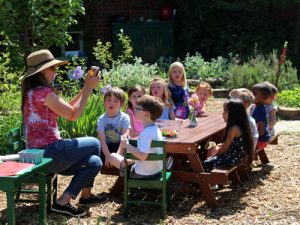
Sara Stratton leads Primary students in making dressing for their strawberry spinach salads.
Springtime is always joyful in Greensboro Montessori School's organic gardens. Winter buds swell and burst, capturing the eyes and hearts of community members, no matter their age! Flowers of all kinds call to us and to our pollinator friends, and sooner than we realize, we reach the height of the season.
This year brought a colder and wetter forecast than in the past. We’ve still yet to harvest our first sugar snap peas, but the strawberries and spinach are out with a vengeance! We continue to enjoy the lushness all the early rain and cool weather brought, even as temperatures rise. Here’s a brief update from our spring adventures!
Primary and Lower Elementary have enjoyed plenty of weeding, watering, planting, and tasting. We just finished a week full of strawberry spinach salads, with a bit of fennel and spring onions thrown in for fun! (Check out the recipe below if you’re interested in trying this at home.) In Upper Elementary, we celebrated the conclusion of our Student Climate Change Summit art exhibition with a persimmon-ginger-honey ice-cream party! Everyone agreed it was fun to make and even better to taste!
Thanks to everyone who attended our Spring Community Garden Workday in the Primary Garden. Together, with roughly 20 volunteers from our school community (ranging in age from 18 months to 70 years old!), we had a blast and accomplished a swath of projects:
- A group of students and dads built a blackberry trellis.
- Sara Stratton supervised several painting projects: our new fence, sink, and picnic tables got all glammed up in a matter of minutes!
- Another dad mixed concrete, which every child who came to the workday used to make a decorative stepping stone.
- Nearly everyone weeded, watered, snacked, swept, and generally left the space looking wonderful for the students, faculty, administration, and all the special guests we welcome in the spring!
What else have we been up to in the organic gardens this spring? We have been incredibly blessed with the generosity of The Fund for GMS. You may have noticed several new Adirondack chairs, benches, swinging benches, outdoor sinks, and chalkboards in all three of our organic gardens. We also have a new Lower Elementary toolshed coming soon. The students have relished in these new additions to their outdoor classrooms, and we couldn’t be more grateful to have such gifts shared with us from within our school community. Thank you, for your continued support of environmental education at Greensboro Montessori School. From all of us on your environmental education teaching team, Happy Spring!
Strawberry Spinach Salad
For the salad:
- 1 pound fresh spinach, washed and spun
- 1 pound fresh strawberries, washed and dried
- 2-3 spring onions, optional
- 2-3 leaves fennel, minced
For the dressing:
- 1/4 cup olive oil
- 1/8 cup balsamic vinegar
- 1 tablespoon honey
- 1 pinch cinnamon
 About the Author
About the Author
Eliza Hudson is Greensboro Montessori School's lead environmental educator. Eliza holds her bachelor's degree in biology from Earlham College in Richmond, Ind. She has built and tended school gardens, taught hands-on cooking lessons and connected local farms to school programs working for FoodCorps. Prior to joining Greensboro Montessori School in 2014, Eliza was a classroom and after-school assistant at the Richmond Friends School, a farm intern at a family-owned farm in Ohio, and served as assistant director at a summer day camp in an urban community garden in Durham.
Greensboro Montessori School has taught environmental education since 1995 and has been permaculture gardening on its campus since 1997.
Greensboro Montessori School's Junior High student council members usually plan three dance parties a year, one each in the fall, winter, and spring. Whether an upcoming dance is your child's first or they have attended these kinds of functions before, we have some details to help you plan ahead.
When: Greensboro Montessori School dances are on a Friday night from 7 to 9:30 p.m.
Where: Dances are hosted in Greensboro Montessori School's Gymnasium
Who: Attendance is limited to currently enrolled students in grades six through nine. In general, students may not bring guests from other schools. In some instances, Greensboro Montessori School has invited other independent schools in the Independent School League to attend dances, but this is the exception to the rule.
Attire: Students may choose to dress up or wear regular clothing. Attire must follow Greensboro Montessori School's dress code. We ask all attendees to wear soft-soled shoes that will not scuff or leave marks on the gym floor.
Chaperones: All dances are chaperoned by faculty and staff from Greensboro Montessori School. On the night of the dance, parents may drop-off their child at the Gymnasium entrance at 7 p.m. and return at 9:30 p.m. when the dance is over. The School always provides the name and cell phone number of at least one chaperone in a personal email to parents.
Cell phones: Students are permitted to bring cell phones to dances.
Entrance Fee: Students pay $5 cash at the door to attend dances.
Music: All Greensboro Montessori School dances have a DJ who is a current student. They develop a playlist based on student requests and submit this playlist for review by their faculty advisor. The faculty advisor reviews the list for content and language and approves only those songs which are age appropriate.

Primary sweet potato biscuits keep students warm on a cold morning.
At Greensboro Montessori School, Environmental Education Curriculum is based on seasonal cycles, the outdoor environment at the School, and the age of the students. We invite spontaneity and often pause to watch and identify insects, marvel at life in the garden, and discuss questions or insights as a community. In all levels we teach about soil, decomposition and compost, pollination, and biodiversity. But what is it we do in winter when the gardens are resting? The short answer is, we teach seasonality and ecology in organic gardens.
Primary students study birds, concentrating on basic identification by sight and sound. They love making binoculars (out of recycled toilet paper rolls) and using them on our bird walks around campus. Along the way, they learn to empathize with birds and their needs, to stop and slow down as not to miss a moment of wonder, and to make an ecological connection between our gardens and the needs of birds: shelter, food, water, and spaces to nest. As the weather warms up, we explore our winter stores of food from the fall gardens - sweet potatoes, garlic, ginger, and honey - in cooking classes, and venture outdoors to observe and relish in the signs of spring!
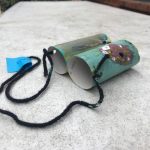
Lower Elementary students' binoculars are treasured tools in class this month.
Lower Elementary students delve even deeper into their bird study, concentrating not only on the basic identification of birds, but also on prolonged observation of bird behavior, habitat, and appreciation for their ecological significance in our organic, permaculture gardens. They love learning how to use and read field guides like ornithologists! I find bird study with this age is a wonderful way to remind children how to sit and soak in the surrounding environment, something we often don’t take time to do when the garden gets growing in spring. Bird watching in winter offers students opportunities to experience peace, critical thought, and insight that they so desperately need after the holiday rush and just before the end of year crunch! As spring break draws near, we share our bird findings with area scientists, cook with our winter food stores, and begin preparing ourselves for spring planting in the garden.
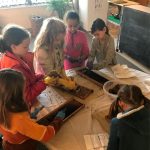
Upper Elementary students save bees wax from a hive that died over the winter. Honey bees and other native bees are a focal point for these students' climate change project.
Upper Elementary winter studies range from native tree and animal projects to redesigning of our Upper School outdoor classroom. This year, we're up to something BIG ... we’re tackling the subject of climate change and how it affects each of us and our experience at Greensboro Montessori School. We're thrilled the culmination of this project will include an art installation we collectively create and participation at the Student Climate Change Summit at UNCG on March 29. The event will be from 5 to 8 p.m. at Weatherspoon Art Museum. Open to the public, the Student Climate Change Summit will feature a wide-array of student participants representing several generations. In addition to our Upper Elementary students presenting their artwork, undergraduate students from UNCG will present research posters around a variety of climate change topics. A student from NC State will describe the work of The Climate Reality Project Campus Corps on their campus. Last but not least, students from the International Baccalaureate (IB) Program at Grimsley High School will present posters highlighting their IB papers on climate change. We hope you will join us at Weatherspoon Art Museum on March 29!
 About the Author
About the Author
Eliza Hudson is Greensboro Montessori School's lead environmental educator. Eliza holds her bachelor's degree in biology from Earlham College in Richmond, Ind. She has built and tended school gardens, taught hands-on cooking lessons and connected local farms to school programs working for FoodCorps. Prior to joining Greensboro Montessori School in 2014, Eliza was a classroom and after-school assistant at the Richmond Friends School, a farm intern at a family-owned farm in Ohio, and served as assistant director at a summer day camp in an urban community garden in Durham.
Greensboro Montessori School has taught environmental education since 1995 and has been permaculture gardening on its campus since 1997.
Have you ever been reminded of an Abbott and Costello skit when talking with your three year old? Ever fallen down a rabbit hole of questions, only to hit the rock bottom of your ability to come up with an answer? If so, you have encountered the phenomenon that is the "Why?" stage. Where does this dizzying vortex of inquiry come from? And, more importantly, when will it stop?
"Get your shoes on, honey. We're going to the store."
"Why?"
"Because we need groceries."
"Why?"
"Because we ate up all our food."
"Why?"
"Because we were hungry."
"Why?"
Maria Montessori provides us with profound insight into the seismic shift in children's cognitive development that takes place around the third birthday. Before this milestone, infants and toddlers are "unconscious, absorbent" learners who acquire skills such as walking and talking without self-awareness or intention, by simply following their own innate desire for autonomy and imitating others in their environment. Around age three, however, they become "conscious" learners, who actively seek knowledge and master new skills through purposeful, deliberate inquiry and practice. It is around this time that many children stumble upon a magical word; one that elicits a seemingly endless wellspring of useful information from adults. Thus begins the litany: "Why? Why? Why?”
In truth, a child's "why?" is not the same question we ask as adults. Yes, children do crave our explanations as they seek to understand their world, but they are not necessarily expecting any elegant, logical, or scientific answers. More often, "why?" translates to: "I'm curious about this topic. I like it when you explain what will happen next. I cherish your attention and the love I feel from you when you talk to me. I want to hear all of the words you know so that I can learn how to use them, too. I want to use long sentences and have conversations, just like you do. Let's practice talking together!" Like a game of verbal ping-pong, each thread of "whys" and responses helps children develop engaging, socially adept conversation skills that will serve them well throughout their lives.
For a great perspective on the whys behind "why," click here for a great article from child psychologist Dr. Alan Green. And to learn more about Montessori's research on the developing brain, please visit our Parent Resource Library, or ask your child's teacher at GMS. (Why? Because we love talking about this stuff.)



